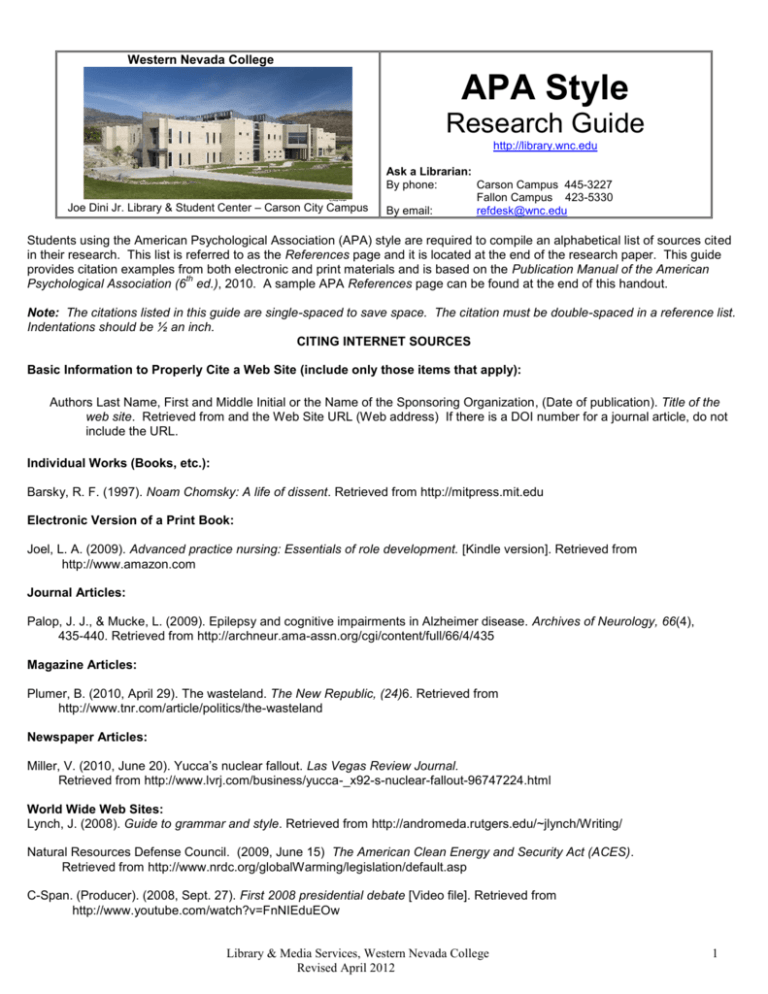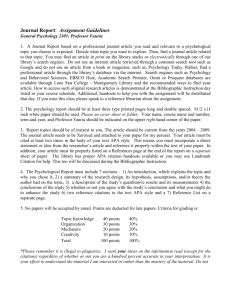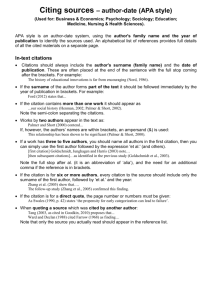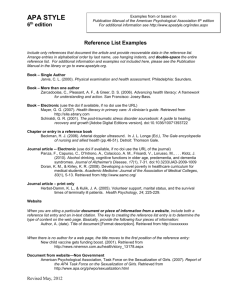apa style sheet for term papers references
advertisement

Western Nevada College APA Style Research Guide http://library.wnc.edu Joe Dini Jr. Library & Student Center – Carson City Campus Ask a Librarian: By phone: Carson Campus 445-3227 Fallon Campus 423-5330 By email: refdesk@wnc.edu Students using the American Psychological Association (APA) style are required to compile an alphabetical list of sources cited in their research. This list is referred to as the References page and it is located at the end of the research paper. This guide provides citation examples from both electronic and print materials and is based on the Publication Manual of the American th Psychological Association (6 ed.), 2010. A sample APA References page can be found at the end of this handout. Note: The citations listed in this guide are single-spaced to save space. The citation must be double-spaced in a reference list. Indentations should be ½ an inch. CITING INTERNET SOURCES Basic Information to Properly Cite a Web Site (include only those items that apply): Authors Last Name, First and Middle Initial or the Name of the Sponsoring Organization, (Date of publication). Title of the web site. Retrieved from and the Web Site URL (Web address) If there is a DOI number for a journal article, do not include the URL. Individual Works (Books, etc.): Barsky, R. F. (1997). Noam Chomsky: A life of dissent. Retrieved from http://mitpress.mit.edu Electronic Version of a Print Book: Joel, L. A. (2009). Advanced practice nursing: Essentials of role development. [Kindle version]. Retrieved from http://www.amazon.com Journal Articles: Palop, J. J., & Mucke, L. (2009). Epilepsy and cognitive impairments in Alzheimer disease. Archives of Neurology, 66(4), 435-440. Retrieved from http://archneur.ama-assn.org/cgi/content/full/66/4/435 Magazine Articles: Plumer, B. (2010, April 29). The wasteland. The New Republic, (24)6. Retrieved from http://www.tnr.com/article/politics/the-wasteland Newspaper Articles: Miller, V. (2010, June 20). Yucca’s nuclear fallout. Las Vegas Review Journal. Retrieved from http://www.lvrj.com/business/yucca-_x92-s-nuclear-fallout-96747224.html World Wide Web Sites: Lynch, J. (2008). Guide to grammar and style. Retrieved from http://andromeda.rutgers.edu/~jlynch/Writing/ Natural Resources Defense Council. (2009, June 15) The American Clean Energy and Security Act (ACES). Retrieved from http://www.nrdc.org/globalWarming/legislation/default.asp C-Span. (Producer). (2008, Sept. 27). First 2008 presidential debate [Video file]. Retrieved from http://www.youtube.com/watch?v=FnNIEduEOw Library & Media Services, Western Nevada College Revised April 2012 1 CITING WNC LIBRARY DATABASES Basic Information to Properly Cite a Journal Article from a Database (include only those items that apply): Author’s last name, First and Middle initial. (Year of publication.) Title of the article. Periodical title, volume (issue), page numbers. DOI number (if given). If there is no DOI number, “Retrieved from” and the URL of the article If a DOI number is available for the article, always put it as the last entry in your citation. If there is no DOI number for the article, end your citation with “Retrieved from” and the URL of the journal, newspaper, or magazine article’s homepage. If you can’t locate the URL of the article, put the URL of the database homepage in the “Retrieved from” portion of the citation. The automatic citation feature of many databases list variations of this format. Check with your instructor to see what version you should use. Some instructors prefer the name of the database instead of the article’s URL (see example at the end of this page.) Ebsco Academic Search Premier Magazine Article: Plumer, B. (2010, April 29). The wasteland. The New Republic, 241(6), 14-15. Retrieved from http://www.thenewrepublic.com Ebsco Academic Search Premier Journal Article, without a DOI Number: Rovira, J. (2009). Blake’s poetry and designs. College Literature, 36(4), 229-231. Retrieved from http://www.collegeliterature.org (NOTE: If pagination is by issue, the issue number is listed.) Ebsco Academic Search Premier Journal Article, with a DOI Number: Frick, T., Chadha, R., Watson, C., Wang, Y., & Green, P. (2009). College student perceptions of teaching and learning quality. Educational Technology Research and Development, 57, 705-720. doi:10.1007/s11423-007-9079-9 (NOTE: If pagination is by volume, the issue number is not listed.) CINAHL Plus with Full Text Library Journal Article with a DOI Number: Kuznar, W. (2010). Sex differences in heart disease trends. American Journal of Nursing, 110(2), 18-19. doi:10.1097/01.NAJ.0000368039.17578.f1 Biography Reference Bank: Jim Harrison. (1992). Current Biography. Retrieved from http://www.hwwilson.com/databases/biobank.cfm Encyclopaedia Britannica: Desmond, A. J. (2009). Charles Darwin. In Encyclopaedia Britannica Online. Retrieved from http://www.britannica.com CQ Researcher: Clemmitt, M. (2010, June 11). Health care reform. CQ Researcher, 20(22), 505-528. Retrieved from http://library.cqpress.com LexisNexis: Rawson, R. A. (2004). Water law and its role in closing the nuclear fuel cycle. Nevada Law Journal, 4, 626+. Retrieved from http://www.lexisnexis.com Opposing Viewpoints: McGowan, R. A. (2006). A short history of gambling in the United States. In D.M. Haugen (Ed.), Legalized gambling. San Diego, CA: Greenhaven Press. Retrieved from http://ic.galegroup.com eHRAF Databases: Redfield, R. (1941). The folk culture of Yucatan. Chicago, IL: University of Chicago Press. Retrieved from http://ehrafworldcultures.yale.edu th Using a Database Name Instead of the URL (matches 5 ed. of APA Style): Cruz, G., & Oloffson, K. (2009, Aug. 24). Driving us to distraction. Time, 174(7), 45-46. Retrieved from Academic Search Premier database. Library & Media Services, Western Nevada College Revised April 2012 2 CITING PRINT SOURCES BOOKS NO AUTHOR Get it together for college. (2008). Princeton, NJ: College Board Publications. ONE AUTHOR Garner, B. A. (2009). Garner’s modern American usage. New York, NY: Oxford University Press. TWO AUTHORS Sweeney, M. S., & Restak, R. (2009). Brain: The complete mind. Washington, DC: National Geographic. THREE TO SEVEN AUTHORS Reichow, B., Doering, P., Cicchetti, D. V., & Volkmar, F. R. (2010). Evidence based practices and treatments for children with autism. New York, NY: Springer. EIGHT OR MORE AUTHORS Davis, L., et. al. (2007). Global warming and climate change. Boston, MA: Little Brown. EDITOR Reis, H. T. (Ed.). (2000). Handbook of research methods in social and personality psychology. New York, NY: Cambridge University Press. EDITION Sommers-Flanagan, J., & Sommers-Flanagan, R. (2008). Clinical interviewing (4th ed.). New York, NY: John Wiley & Sons. SEVERAL VOLUMES Esposito, J. L. (Ed.). (2004). Islamic world: Past and present. (Vols. 1-3). New York, NY: Oxford University Press. ESSAY OR ARTICLE IN A COLLECTION Capote, T. (2008). Then it all came down. In Schechter, H. (Ed.), True crime: An American anthology (pp. 651-661). New York, NY: Library of America. ENCYCLOPEDIA ARTICLES SIGNED Dine, M. (2010). Relativity. In The world book encyclopedia (Vol. 16, pp. 209-212). Chicago, IL: World Book, Inc. UNSIGNED Esperanto. (2010). In The world book encyclopedia (Vol. 6, p. 358 ). Chicago, IL: World Book, Inc. REFERENCE BOOKS Symbicort. (2010). In Physician's desk reference (pp. 720-732). Montvale, NJ: Medical Economics. JOURNALS, MAGAZINES & NEWSPAPERS JOURNAL ARTICLE WITHOUT A DOI NUMBER (IF PAGINATION IS BY ISSUE, THE ISSUE NUMBER IS LISTED) Rovira, J. (2009). Blake’s poetry and design. College Literature, 36(4), 229-231. JOURNAL ARTICLE WITH A DOI NUMBER (IF PAGINATION IS BY VOLUME, THE ISSUE NUMBER IS NOT LISTED) Frick, T., Chadha, R., Watson, C., Wang, Y., & Green, P. (2009). College student perceptions of teaching and learning quality. Educational Technology Research and Development, 57, 705-720 doi:10.1007/s11423-007-9079-9 MAGAZINE ARTICLE, SIGNED Plumer, B. (2010, April 29). The wasteland. The New Republic, 241(6), 14-15. MAGAZINE ARTICLE, UNSIGNED Facebook and you. (2010, May 31). Time, 175(21), 34-35. ENTIRE ISSUE OF A JOURNAL Glass, R. M. (Ed.). (2010). Mental Health [Special issue]. JAMA: The Journal of the American Medical Association, 303(19). NEWSPAPER ARTICLE, UNSIGNED Yucca still kicking. (2009, February 25). Las Vegas Review Journal, p. 4B. NEWSPAPER ARTICLE, SIGNED Miller, V. (2010, June 20). Yucca’s nuclear fallout. Las Vegas Review Journal, p. 1E Library & Media Services, Western Nevada College Revised April 2012 3 APA REFERENCE CITATIONS IN THE TEXT OF RESEARCH PAPERS The purpose of the in-text citation is to acknowledge the use of material used from another source in the body of your research paper. When using material from another source, briefly identify the source used so that the reader can locate the full citation in the list of references at the end of the paper. Citations used in the text of paper must appear in the list of references at the end of the paper, except as noted below. For th a further explanation of in text citations, see the Publication Manual of the American Psychological Association (6 ed.), pp. 169-192. th Another good source of information on in text citations is Diane Hacker’s Research and Documentation Online (5 ed.) (http://bcs.bedfordstmartins.com/resdoc5e/RES5e_ch09_s1-0001.html ). To cite a specific part of a source, indicate the page, chapter, figure, table, or equation at the appropriate point in the paper. Always give page numbers for quotations: (Sweeney & Restak, 2009, p. 10) (Garner, 2009, chap. 3) If you are citing an electronic source that doesn’t provide page numbers, you can use the paragraph number: (Garner, 2009, para. 3) The name of the author and the date of publication are inserted, usually in parentheses, at appropriate points in the text: Reis (2000) compared reaction times in a similar cohort. A recent study of reaction times (Reis, 2000) found similar results. In 2000, Reis found that reaction times varied considerably. . When a work has two authors, always cite both names: It has been shown in recent studies (Sweeney & Restak, 2009) that this theory is still valid. Sweeney and Restak (2009) compared recent research studies on this topic. When there are three or more authors and fewer than six, all authors are cited the first time. In subsequent citations, include only the last name of the first author followed by "et al." and the year: Reichow, Doering, Cicchetti, & Volkmar (2010) found that cognitive [first time cited] Reichow et al. (2010) also found that educational [subsequent citations] When there are six or more authors, cite only the last name of the first author followed by "et al." and the year for the first and subsequent citations. (In the reference list, the last names of all the authors are spelled out.): Recently a study (Davis et al., 2007) has shown that this theory may not be valid in all circumstances. When a work has no author, cite the first two or three words, starting with the same words you used in the reference list. Use double quotation marks around the title of an article or chapter and italicize the title of a periodical or book: Social networking has changed the way people communicate (“Facebook and you”, 2010) The book Get it together for college (2008) describes the study habits of current students. If you are citing two works by authors with the same last name, include the author's initials in all text citations to avoid confusion: R. E. Davis (2007) and L. T. Davis (2005) also found similar results. Arrange two or more works by the same author in order by year of publication. Give the author's last name once; for each subsequent work, give only the date: Past research (Sweeney & Restak, 2002, 2009) arrives at the same conclusion. List two or more works by different authors who are cited within the same parentheses in alphabetical order by their last names. Separate the citations by a semicolon: Several studies (Bernstein, 2001; Sweeney & Restak, 2009; Grey, 2007) indicate a similar correlation. The names of corporate authors are usually spelled out each time they appear in the paper. The names of some corporate authors are spelled out in the first citation and are abbreviated thereafter. In deciding whether to abbreviate the name of the corporate author, use the general rule that you need to give enough information in the next citation for the reader to locate the entry in the reference list without difficulty. If the name of the corporate author is long and cumbersome and if the abbreviation is familiar or readily understandable, you may abbreviate the name in the second and subsequent citations. If the name is short or if the abbreviation would not be readily understandable, spell out the name each time it occurs: Statistics have been gathered (National Institute of Mental Health [NIMH], 2010) [first citation] to support this theory. (NIMH, 2010) [subsequent citations] Personal communications may be letters, memos, telephone conversations, or interviews. Because they do not provide recoverable data, personal communications are not included in the reference list. Cite personal communications in the text only. Give the initials as well as the last name of the communicator and provide as exact a date as possible: J. O. Reiss (personal communication, April 18, 2010) stated that he agreed with most scientists on this matter. (J. O. Reiss, personal communication, April 18, 2010) Library & Media Services, Western Nevada College Revised April 2012 4 USEFUL WEB SITES FOR APA STYLE CITATIONS APA Citation Examples. This site, from the University of Maryland, provides clear and concise guidelines for citing sources in the APA style. (http://www.umuc.edu/library/guides/apa.shtml) APA (American Psychological Association) Citation Style. An excellent overview of the APA citation style from Cornell University. (http://www.library.cornell.edu/resrch/citmanage/apa) APA Formatting and Style Guide. APA citation style guidelines from the Online Writing Lab at Purdue University. (http://owl.english.purdue.edu/owl/resource/560/01/) APA Style. Information on the APA citation style from the American Psychological Association. (http://www.apastyle.org/) APA Style Citation Guide. A very useful guide to APA style citation from the Seattle Central Community College Library. (http://dept.sccd.ctc.edu/cclib/Research_Help/Citation_Style_Guides/apa_pdf.asp) Research and Documentation Online: APA Style and Sample Research Paper. You can find examples of APA in-text citations, information on how to format a paper, and instructions on compiling a list of references on this site. This page also has a sample research paper written in the APA style. (http://bcs.bedfordstmartins.com/resdoc5e/RES5e_ch09_o.html) KnightCite Bibliography Machine. A free citation composer from Calvin College. This site will help you compile a citation list in APA, Chicago, or MLA styles. (http://www.calvin.edu/library/knightcite/index.php). A list of other citation generators can be found at Guide to Citation Generators (http://library.albany.edu/reference/citegen.html#manauls). BOOKS ON WRITING RESEARCH PAPERS USING APA STYLE CITATIONS th American Psychological Association. (2010). Concise rules of APA style (6 ed.). Washington, DC: Author. (BF76.7 .C88) th American Psychological Association. (2010). Publication manual of the American Psychological Association (6 ed.). Washington, DC: Author. (BF76.7 .P83) th Ballenger, B. (2009). The curious researcher. (6 ed.). New York, NY: Longman. (LB2369 .B246) Coyle, W., & Law, J. (2010). Research papers. (15th ed.). New York, NY: Longman. (LB2369 .C65) th Hacker, D. (2010). The Bedford handbook. (8 ed.). Boston, MA: Bedford/St. Martins. (PE1408 .H277) Hacker, D. (2009). A pocket style manual. Boston, MA: Bedford/St. Martins. (PE1408 .H2778) Hacker, D. (2011). A writer’s reference. Boston, MA: Bedford/St. Martins. (PE1408 .H2778) Lester, J. D., Sr., & Lester, J. D., Jr. (2010). Writing research papers: A complete guide. (13th ed.). New York, NY: Longman. (LB2369 .L4) Reid, S. (2011). The Prentice Hall essential guide for college writers. (9th ed.). Upper Saddle River, NJ: Prentice Hall. (PE1408 .R424) Library & Media Services, Western Nevada College Revised April 2012 5 Sample APA References Page page number Title of paper The Maya Folk Culture 10 References Berlage, G. (1995). Maya architecture. Westport, CT: Greenwood Press. Evans, S. B. (2004). Ancient Mexico and Central America. London, England: Thames & Hudson. Fields, H. (2004, May 17). When they were kings. U.S. News & World Report, 136(17), 74-76. Retrieved from http://www.usnews.com Florescano, E. (2006). Chichén Itzá, Teotihuacán and the origins of the Popol Vuh. Colonial Latin American Review, 15(2), 129-142. doi:10.1080/10609160600958553 Gorman, J. (2002, July 20). The original cocoa treat. Science News, 162(2), 38-39. Retrieved from http://www.sciencenews.org Lucero, L. (2006). Maya political science: Time, astronomy and the cosmos. Antiquity, 80(307), 226-227. Retrieved from http://antiquity.ac.uk Milbrath, S. (2005, March/April). Last great capital of the Maya. Archaeology, 58(2), 26-29. Retrieved from http://archaeology.org Morley, S. G. (1983). The ancient Maya. Stanford, CA: Stanford University Press. Popson, C. (2003, January/February). Maya goods in Teotihuacan tomb. Archaeology, 56(1), 16. Retrieved from http://archaeology.org Redfield, R. (1941). The folk culture of Yucatan. Chicago, IL: University of Chicago Press. Retrieved from http://ehrafworldcultures.yale.edu Sosa, J.R., & Skoggard, I. A. (2001). Cultural summary: Maya (Yucatan Peninsula). Retrieved from http://ehrafworldcultures.yale.edu Zackowitz, M. (2003, August). Royal city of the Maya. National Geographic, 204(2), 96-99. Retrieved from http://ngm.nationalgeographic.com Indents should be ½ inch or 5 spaces






